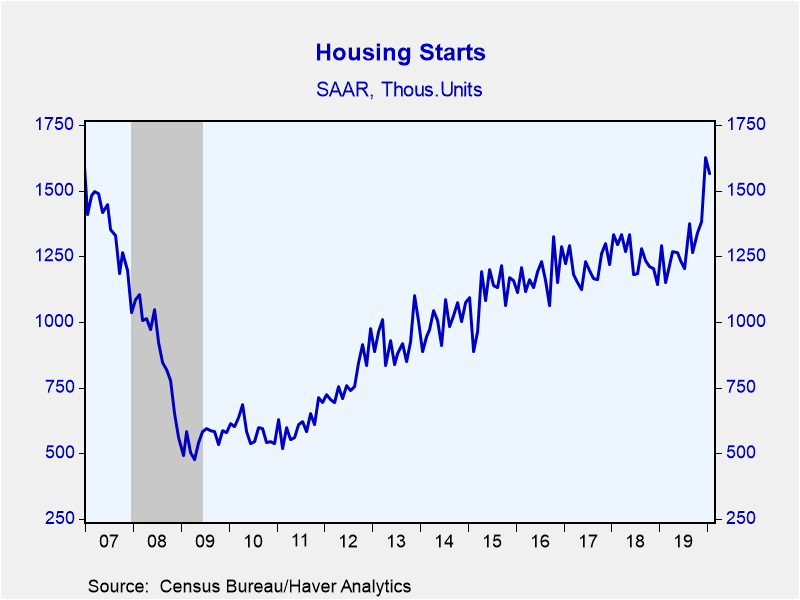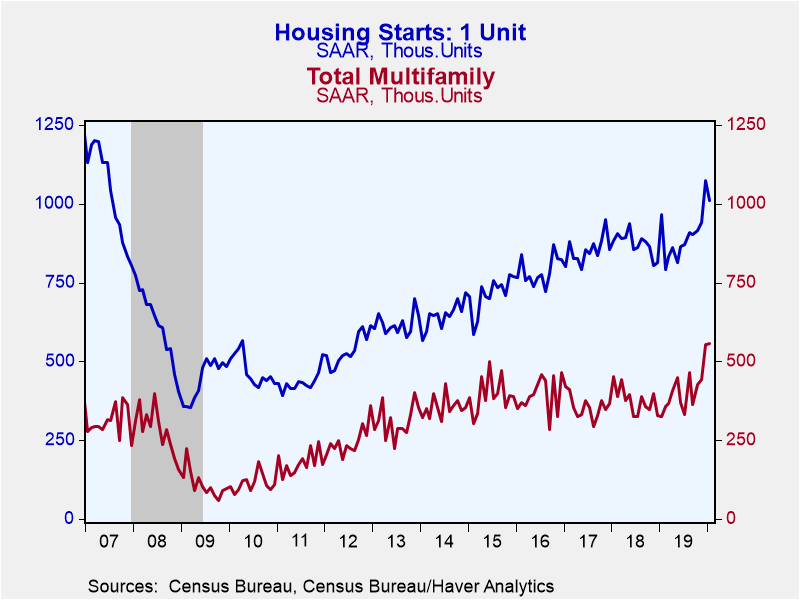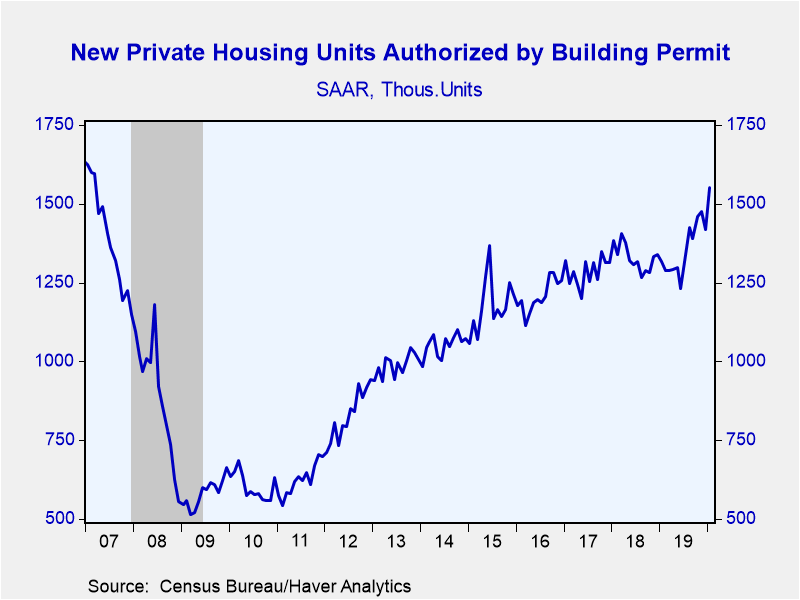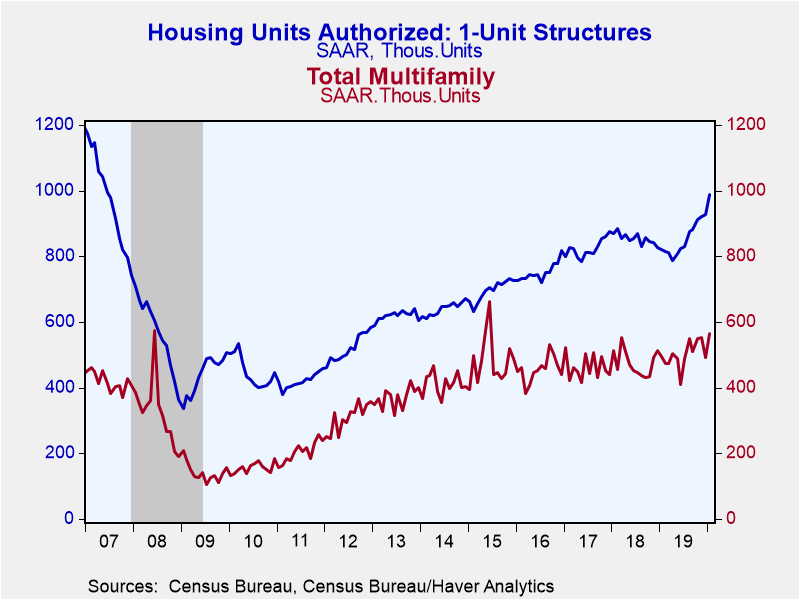 Global| Feb 19 2020
Global| Feb 19 2020U.S. Housing Starts Give Back Some of December Gains in January
by:Sandy Batten
|in:Economy in Brief
Summary
Housing starts fell 3.6% m/m (+21.4% y/y) in January to 1.567 million units at an annual rate, giving back some of the outsized weather-aided 17.7% m/m jump in December (1.626 million units), which was revised up from a 16.9% m/m gain [...]
Housing starts fell 3.6% m/m (+21.4% y/y) in January to 1.567 million units at an annual rate, giving back some of the outsized weather-aided 17.7% m/m jump in December (1.626 million units), which was revised up from a 16.9% m/m gain (1.608 million units). Still, the decline was smaller than had been anticipated by the Action Economics Forecast Survey, which looked for a decline in January to 1.420 million units.
The January retreat in total starts was due completely to weaker single-family starts, which fell 5.9% m/m (+4.6% y/y) to 1.010 million units. Multi-family starts in January added to their marked 25.4% m/m December surge by edging up 0.7% m/m (+71.4% y/y) to 557,000 units. Multi-family starts are now at their highest level since December 1986. Residential investment in the national accounts rose in both Q3 and Q4; January housing starts point to a robust 2020 Q1 as starts in January were 8.1% above the Q4 average.
Building permits were stronger than expected in January, rising 9.2% m/m (17.9% y/y) to 1.551 million units after having fallen 3.7% m/m in December. The January reading was the highest since March 2007. The issuance of permits is not nearly as affected by weather as are starts. Permits to build single-family homes rose 6.4% m/m (20.2% y/y) to 987,000 while multi-family permits jumped 14.6% m/m (13.9% y/y) to 564,000.
By region, housing starts jumped up 31.9% m/m to 178,000 units in the Northeast and edged up 1.2% m/m to 431,000 in the West. In contrast, starts slumped 25.9% m/m to 180,000 in the Midwest and fell 5.4% m/m to 778,000 in the South.
The housing starts and permits figures can be found in Haver's USECON database. The expectations figure is contained in the AS1REPNA database.
The minutes to the latest FOMC meeting can be found here.
| Housing Starts (000s, SAAR) | Jan | Dec | Nov | Jan Y/Y % | 2019 | 2018 | 2017 |
|---|---|---|---|---|---|---|---|
| Total | 1,567 | 1,626 | 1,381 | 21.4 | 1,300 | 1,250 | 1,209 |
| Single-Family | 1,010 | 1,073 | 940 | 4.6 | 894 | 873 | 852 |
| Multi-Family | 557 | 553 | 441 | 71.4 | 405 | 377 | 357 |
| Starts By Region | |||||||
| Northeast | 178 | 135 | 107 | 23.6 | 115 | 111 | 111 |
| Midwest | 180 | 243 | 172 | 27.7 | 171 | 171 | 181 |
| South | 778 | 822 | 748 | 9.1 | 691 | 631 | 603 |
| West | 431 | 426 | 354 | 47.1 | 324 | 337 | 314 |
| Building Permits | 1,551 | 1,420 | 1,474 | 17.9 | 1,350 | 1,330 | 1,286 |
Sandy Batten
AuthorMore in Author Profile »Sandy Batten has more than 30 years of experience analyzing industrial economies and financial markets and a wide range of experience across the financial services sector, government, and academia. Before joining Haver Analytics, Sandy was a Vice President and Senior Economist at Citibank; Senior Credit Market Analyst at CDC Investment Management, Managing Director at Bear Stearns, and Executive Director at JPMorgan. In 2008, Sandy was named the most accurate US forecaster by the National Association for Business Economics. He is a member of the New York Forecasters Club, NABE, and the American Economic Association. Prior to his time in the financial services sector, Sandy was a Research Officer at the Federal Reserve Bank of St. Louis, Senior Staff Economist on the President’s Council of Economic Advisors, Deputy Assistant Secretary for Economic Policy at the US Treasury, and Economist at the International Monetary Fund. Sandy has taught economics at St. Louis University, Denison University, and Muskingun College. He has published numerous peer-reviewed articles in a wide range of academic publications. He has a B.A. in economics from the University of Richmond and a M.A. and Ph.D. in economics from The Ohio State University.










